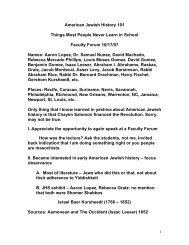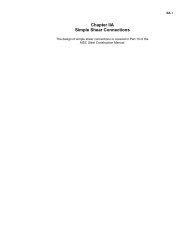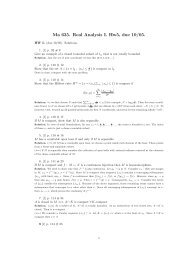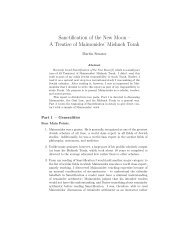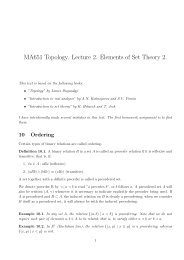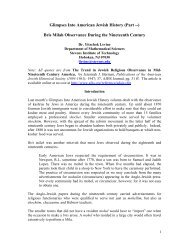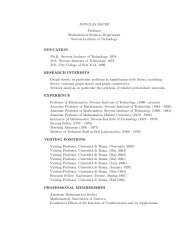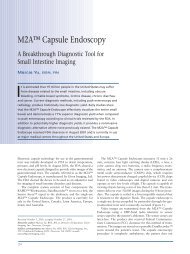Moses Raphael Levy - Stevens Institute of Technology
Moses Raphael Levy - Stevens Institute of Technology
Moses Raphael Levy - Stevens Institute of Technology
You also want an ePaper? Increase the reach of your titles
YUMPU automatically turns print PDFs into web optimized ePapers that Google loves.
Glimpses Into American Jewish History (Part --)<br />
<strong>Moses</strong> <strong>Raphael</strong> <strong>Levy</strong> – Wealthy Colonial Jewish Merchant<br />
Dr. Yitzchok Levine<br />
Department <strong>of</strong> Mathematical Sciences<br />
<strong>Stevens</strong> <strong>Institute</strong> <strong>of</strong> <strong>Technology</strong><br />
Hoboken, NJ 07030<br />
llevine@stevens.edu<br />
For centuries Jews believed America to be a land <strong>of</strong> freedom and financial opportunity.<br />
One such Jew was <strong>Moses</strong> <strong>Raphael</strong> <strong>Levy</strong> (1665 – 1728) who achieved tremendous<br />
financial success as an American colonial merchant.<br />
<strong>Levy</strong> was born in 1665 in Germany to Isaac and Beila <strong>Levy</strong>. He relocated to England<br />
and his marriage to his first wife, Richea (Rycha) Asher, took place in 1695 1 in London’s<br />
Bevis Marks Synagogue. Three children were born in London – Bilhah Abigail (b.<br />
1696), Asher (b. 1699), and Nathan (b. 1704). According to family tradition, <strong>Moses</strong><br />
enjoyed some financial success in England. “After accumulating something <strong>of</strong> a<br />
competency in London, he thought he saw in the New World opportunities for adding to<br />
it, and about the year 1705 landed in New York City.” 2 The <strong>Levy</strong>s were accompanied by<br />
<strong>Moses</strong>’ brother, Samuel, and his wife, Rachel Asher who was Beila’s sister. (The practice<br />
<strong>of</strong> brothers solidifying family and business ties by marrying sisters was not uncommon at<br />
this time.) A young man named Jacob Franks, who would eventually marry Bilhah<br />
Abigail, also came with them. 3<br />
“As Ashkenazim, the <strong>Levy</strong>s found themselves outnumbered. New York had been settled<br />
by Sephardim, who constituted a majority <strong>of</strong> its Jewish residents. Because there was no<br />
organized Ashkenazic community in New York until the nineteenth century, the <strong>Levy</strong>s<br />
had no choice but to turn for communal support to the Sephardic establishment. They<br />
were allowed to join the Sephardic community with the understanding that they would<br />
conform to Sephardic customs. They did, and gradually became accepted as “naturalized”<br />
Sephardim.”<br />
<strong>Moses</strong> <strong>Levy</strong> took an active interest in New York’s Congregation Shearith Israel and<br />
served as its Parnas (President) for several years. Indeed, he was serving that <strong>of</strong>fice<br />
when he passed away on June 14, 1728.<br />
However, his main interests were financial.<br />
“Taking full advantage <strong>of</strong> business and family connections in London and the West<br />
Indies, <strong>Levy</strong> soon became so successful in exporting beaver pelts and grain and importing<br />
a variety <strong>of</strong> manufactured goods that he controlled a fleet <strong>of</strong> ships, one <strong>of</strong> which he<br />
named after his daughter, Abigail. With the emergence <strong>of</strong> a thriving American export<br />
economy <strong>of</strong> grains, furs, and hides, <strong>Levy</strong> became ever more involved in commerce and<br />
trade. Business was so good that in 1711 <strong>Levy</strong> joined several other wealthy Jewish<br />
1
merchants in contributing to a fund for the completion <strong>of</strong> a spire on Trinity Church on<br />
Broadway and Wall Street, making the church the tallest man-made structure in the city.<br />
It was an investment that paid <strong>of</strong>f. Four years later, the New York Assembly passed a bill<br />
naturalizing all resident landowners <strong>of</strong> foreign birth, regardless <strong>of</strong> religion. This law<br />
entitled <strong>Levy</strong> and his heirs to the same rights and obligations their Gentile neighbors<br />
enjoyed.<br />
“In 1716 <strong>Levy</strong>’s wife Richea died, leaving <strong>Levy</strong> with five children. Two years later, in<br />
London, <strong>Levy</strong> married Grace Mears <strong>of</strong> Spanish Town, Jamaica, where a Sephardic<br />
community had existed for over half a century. Grace bore <strong>Levy</strong> seven children.” 4<br />
Their first child Rachel was born in London in 1719. She was the mother <strong>of</strong> Gershom<br />
Mendes Seixas, who served as Hazzan <strong>of</strong> Congregation Shearith Israel from 1768 to 1776<br />
and again from 1784 until his passing in 1816. (Shearith Israel did not function during the<br />
Revolutionary War, since many <strong>of</strong> New York’s Jews left the city rather than live under<br />
the British when they captured the city. Seixas led this exodus and is <strong>of</strong>ten referred to as<br />
the Revolutionary War Hazzan.)<br />
Some <strong>of</strong> <strong>Levy</strong>’s twelve children “became the ancestors <strong>of</strong> very distinguished Jews in the<br />
generations to follow. One <strong>of</strong> his sons was the real founder <strong>of</strong> the Philadelphia Jewish<br />
community, another was one <strong>of</strong> the first Jews in Baltimore. A grandson <strong>of</strong> his, likewise named<br />
<strong>Moses</strong> <strong>Levy</strong>, was considered by Jefferson for a cabinet post.” 5 The Liberty Bell was transported<br />
to America on the ship Myrtilla which belonged to Nathan <strong>Levy</strong>, <strong>Moses</strong>’ eldest son.<br />
<strong>Levy</strong> did suffer the ups and downs <strong>of</strong> the business world in his many financial endeavors.<br />
“That the merchant-shipper <strong>of</strong> that generation only too frequently suffered reverses is<br />
eloquently demonstrated in <strong>Levy</strong>’s relations with Isaac Napthaly, a Rhode Island butcher<br />
who also aspired to be a merchant. By 1705, Napthaly, now in New York, had been<br />
granted the freedom <strong>of</strong> the city; the following year, while engaged in litigation <strong>of</strong> some<br />
sort, he succeeded in inducing <strong>Levy</strong> to become his bondsman. Two years later Napthaly<br />
ran up a debt with <strong>Levy</strong> in a commercial deal and then fled the country. He was probably<br />
hopelessly bankrupt and ran away to escape imprisonment for debt. <strong>Levy</strong> was now<br />
compelled to pay the bond and the costs <strong>of</strong> the suit, and he lost what he himself had<br />
advanced in goods and credits. All told, the fugitive cost him over £ 176, to say nothing<br />
<strong>of</strong> incidental expenses in the affair. Years later <strong>Levy</strong> heard that Napthaly had passed<br />
away, ‘in parts remote ... beyond the seas, intestate,’ but he also heard that he did leave<br />
some small effects in New York. Accordingly, <strong>Levy</strong> petitioned Governor William<br />
Burnett for letters <strong>of</strong> administration as principal creditor, and received them; he probably<br />
salvaged very little <strong>of</strong> the original credits now due for almost fifteen years.” 6<br />
Nonetheless, <strong>Moses</strong> <strong>Levy</strong>’s immigration to America, the land <strong>of</strong> opportunity, paid <strong>of</strong>f<br />
handsomely, as the following incident shows. <strong>Levy</strong> took out an ad in the April 14, 1726<br />
issue <strong>of</strong> the New York Gazette in which he announced that he wanted to sell “a house in<br />
the town <strong>of</strong> Rye, with about sixty or seventy acres <strong>of</strong> upland and about five acres <strong>of</strong><br />
meadow, together with part <strong>of</strong> mansion, formerly belonging to John Heward and now to<br />
<strong>Moses</strong> <strong>Levy</strong>, in New York, or any part there<strong>of</strong>, on reasonable terms to any person that<br />
2
has a mind to purchase the same.” He added that he may be found “over against the Post<strong>of</strong>fice.”<br />
7<br />
“<strong>Moses</strong> <strong>Levy</strong>’s personal stature, civic attainments and early Americanization are best<br />
captured in the portraits (all in the collection <strong>of</strong> the American Jewish Historical Society)<br />
not only <strong>of</strong> himself but also <strong>of</strong> his daughters Rachel and Abigail, his son-in-law Jacob<br />
Franks, and his grandchildren David and Phila Franks. It is by far the most complete<br />
visual record we have <strong>of</strong> an early colonial American Jewish family. Decked out in an<br />
imposing powdered wig and a greyhound at his side symbolizing his landowning status<br />
(unattainable for a Jew elsewhere in the Christian world) <strong>Levy</strong> radiates the well-fed<br />
comfort and well-bred confidence <strong>of</strong> a successful merchant-landowner.” 8<br />
1 First American Jewish Families: 600 Genealogies, 1654-1988 by Malcolm H. Stern, Third Edition,<br />
American Jewish Archives, 1991, page 154. (http://americanjewisharchives.org/FAJF/intro.php )<br />
2 The <strong>Levy</strong> and Seixas Families <strong>of</strong> Newport and New York by N Taylor Phillips Publications <strong>of</strong> the<br />
American Jewish Historical Society (1893-1961); 1896; 4, AJHS Journal, page 189 (Available at<br />
http://www.ajhs.org/scholarship/adaje.cfm)<br />
3<br />
See "Bilhah Abigail Franks: Early American Jewish Matriarch" The Jewish Press, October 7, 2011,<br />
pages 24 & 26.<br />
4 The Seixas-Kursheedts and the Rise <strong>of</strong> Early American Jewry by Kenneth Libo and Abigail<br />
Kursheedt H<strong>of</strong>fman, Bloch Publishing Company in conjunction with the AJHS, 2001, page 3.<br />
5 Early American Jewry, The Jews <strong>of</strong> New York, New England and Canada, 1649 – 1794 by Jacob<br />
Radar Marcus, The Jewish Publication Society <strong>of</strong> America, 1951, page 51.<br />
6 Ibid., page 52.<br />
7 The <strong>Levy</strong> and Seixas Families <strong>of</strong> Newport and New York<br />
8 http://sephardicoralhistory.org/education/essays.php?action=show&id=37<br />
3



